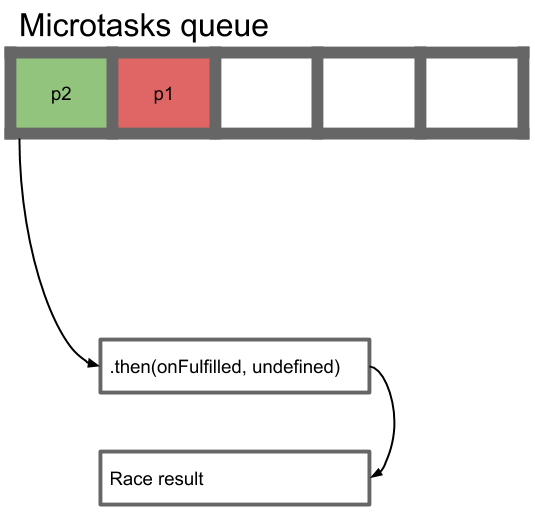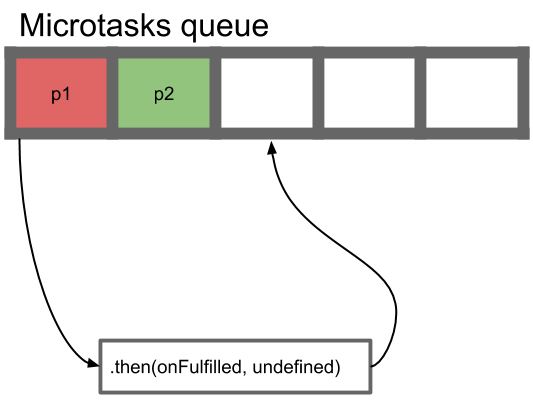by Max Belsky
The real difference between catch vs onRejected
Most popular articles describe the difference between catch and onRejected in a code snippet like this:
const getPromise = () => new Promise((resolve, reject) => { Math.round(Math.random()) ? resolve('resolve #1') : reject('reject #1')})getPromise().then(result => { throw new Error('reject #2')}, error => { // Handles only 'reject #1'})getPromise().then(result => { throw new Error('reject #2')}) .catch(error => { // Handles both 'reject #1', // and 'reject #2' }))onRejected never handles rejected promises from the same .then(onFulfilled) callback and .catch takes both. However besides the behavior difference, there is one more nuance. It’s about how these ways will be translated to microtasks and how they will be queued.
Let’s see an example of the difference.
Promise.race
There is a task — write Promise.race polyfill. We use a common pattern in both functions to handle resolved promises and different tools to handle rejected promises.
const promiseRaceOnRejected = (promises = []) => { return new Promise((resolve, reject) => { promises.forEach(promise => { promise.then( result => resolve(result), error => reject(error) ) }) })}const promiseRaceCatch = (promises = []) => { return new Promise((resolve, reject) => { promises.forEach(promise => { promise.then(result => resolve(result)) .catch(error => reject(error)) }) })}Try some tests to be sure that both solutions work well:
// A helper function to create a delayed promiseconst getPromise = (resolveMs, rejectMs) => { return new Promise((resolve, reject) => { if ('number' === typeof rejectMs) { setTimeout(() => reject(rejectMs), rejectMs) } if ('number' === typeof resolveMs) { setTimeout(() => resolve(resolveMs), resolveMs) } })}const testRaces = async () => { const r1 = await promiseRaceOnRejected([ getPromise(0), getPromise(5) ]) // 0const r2 = await promiseRaceCatch([ getPromise(0), getPromise(5) ]) // 0const r3 = await promiseRaceOnRejected([ getPromise(5), getPromise(null, 2) ]) .catch(e => e) // 2const r4 = await promiseRaceCatch([ getPromise(5), getPromise(null, 2) ]) .catch(e => e) // 2}testRaces()As you can see, both polyfills work as expected. Arguments order and rejected promises handler variation don’t matter. Until we try it with the next set of tests:
const r5 = await promiseRaceOnRejected([ Promise.resolve('Resolve'), Promise.reject('Reject') ]) // Resolveconst r6 = await promiseRaceCatch([ Promise.resolve('Resolve'), Promise.reject('Reject') ]) // Resolveconst r7 = await promiseRaceOnRejected([ Promise.reject('Reject'), Promise.resolve('Resolve') ]) .catch(e => e) // Rejectconst r8 = await promiseRaceCatch([ Promise.reject('Reject'), Promise.resolve('Resolve') ]) .catch(e => e) // ???The fifth, sixth and seventh races return expected values. What about the eighth? Instead of Reject it returns Resolve and it is not a bug.
Microtasks queue
Depending on the job’s result, a pending promise changes its state to resolved or rejected. JS environment puts that promise in a microtasks queue. Like it described in ECMA 2015 specification, this queue works by the FIFO principle — first in, first out. Base on this, let’s review the eighth race’s case.

At the start of the race, we already have two queued promises, and the rejected is first. .then without a second argument cannot handle a rejected promise, so it puts the promise back into the queue. And instead of handling this promise with .catch, the JS environment switches to p2 because it has higher priorities in the queue.

On next tick .then handles p2 and the race ends with Resolve result.
Next time when you’re choosing between the catch and onRejected handlers, remember not only which rejected promises they catch, but about the queuing difference too!
